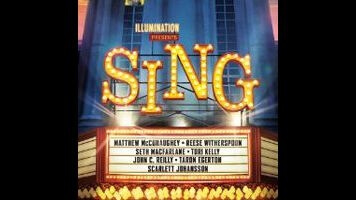The animated karaoke bash Sing aims for cute but lands on irritating

Illumination Entertainment is an American computer-animation company, but its first feature, the extremely popular Despicable Me, applied an angular, vaguely European flair to some of its character designs, setting the film apart from the rounded cuteness of Disney and Pixar. Perhaps this could be chalked up to lead character Gru, a riff on James Bond-style supervillains, or to the French nationality of Despicable Me director Pierre Coffin. Whatever the reasons behind this distinction, the house style has mutated in time for Sing, Illumination’s crowd-pleasing karaoke musical. The film looks European only in the sense that it resembles the poor-man’s-Pixar stylings often seen clogging up the animated short programs that circulate around Oscar time.
In a way, Sing deserves credit for bravely rejecting cuteness as a dominant animation aesthetic—though it’s not clear that the movie knows it’s doing this. It seems like Buster Moon (Matthew McConaughey), a big-dreaming hustler of a koala bear who runs a theater, is supposed to be cute, as are aspiring singers Rosita (a pig voiced by Reese Witherspoon), Johnny (a gorilla voiced by Taron Egerton), and Ash (a porcupine voiced by Scarlett Johansson), among others. But all of these animal characters, inhabitants of a multi-species city that’s like a boring version of Zootopia, are drawn with strangely small, close-set eyes and broad faces. It’s nice to see a different physical archetype in big-studio family-targeted animation, but it’s a little disconcerting that, say, Rosita and her family look like they could comfortably relocate to the lethargic, late-middle-aged animal kingdom of the comic strip Pluggers.
It’s disappointing to learn that the architect of these unappealing visuals is Garth Jennings, who as one half of the directing duo Hammer & Tongs is well-versed in the art of heart-tugging cuteness, having made the music video for Blur’s “Coffee & TV” (among many others) as well as the frequently adorable live-action film Son Of Rambow. There are no traces of his lovable quirkiness in this production, which follows Buster’s desperately optimistic attempts to save the theater his father helped build by having the idea for American Idol 15 years later. Buster’s oft-professed love of the theatrical arts somehow gets translated to an appreciation of high-stakes karaoke, so he decides to hold a local singing contest with a cash prize that gets mistakenly inflated on the flyers he prints, drawing a huge menagerie of interested animals. (It’s unclear whether Buster has checked with the Muppets about the viability of holding talent contests as a means of saving an old theater.)
This is how the movie introduces its ensemble of dreamers. Rosita is a frustrated housewife and mother to dozens of unruly piglets, her aspirations ignored and unrealized. (Seriously, she’s a perfect candidate for future Plugger-dom). Johnny’s father and brothers are dedicated to a life of crime and don’t know or care about his ability to mope-sing like Sam Smith. (Missed opportunity there, not just calling the character Simian Smith). Ash plays rock music with her boyfriend, who keeps nudging her out of the spotlight. Real-life singer Tori Kelly voices Meena, an elephant with a lot of talent but not much self-confidence. These characters are all engineered to generate maximum sympathy, and in between the attempts to yank heartstrings, the animation provides a few endearing sights: the diminutive Buster perched atop a spindly bicycle; a tough-talking, velvet-voiced mouse (Seth MacFarlane) going on a card-playing, womanizing tear at the mere thought of winning the prize money; the bank-robbing gorillas attempting to disguise themselves with tiny bunny masks.
But most of the time, the movie rejects real gags, whether verbal or visual, in favor of juxtapositions designed to fool undiscerning audiences (parents as much as their children) into thinking they’ve experienced an actual joke. This tendency is especially pronounced during the movie’s long auditions sequence. There’s an ox singing “Butterfly” by Crazy Town! And there’s a group of bunnies singing “Anaconda” by Nicki Minaj, and, more nonsensically, they’re actually singing the part of that song that samples “Baby Got Back”—but the point is, they say “Look at her butt,” which the movie obviously thinks is hilarious. The filmmakers behind Sing would doubtless testify to the love of music that fuels the movie’s dozens upon dozens of recognizable pop music cues. But really, it’s the cues they love, not the songs or performances, as the movie repeatedly chases the ephemeral flash of recognition that occurs when listeners hear songs they know before moving on to the next familiar riff. It’s like cycling through an extremely basic iPod on shuffle with an itchy trigger finger.
Eventually, the movie begins showing climactic full performances by its characters, and while it’s novel to hear Witherspoon take on “Shake It Off” (alongside Nick Kroll, no less) or Johansson tear into a pop-punk original, by this point Sing has committed too many sins to ignore. These include but are not limited to: inserting several obligatory yet unnecessary frenetic chases; indulging Seth MacFarlane’s crooner aspirations; perpetuating the idea that one of a singer’s main responsibilities is actually dancing; padding the running time close to the two-hour mark; and taking the dance-party-ending style of contemporary animation to almost experimental lengths. It turns out that Sing’s myriad irritations are a lot more eclectic than its long, long playlist of pop hits.